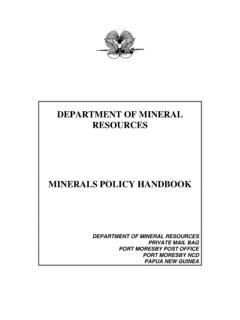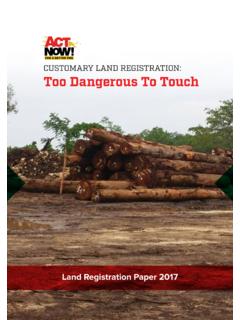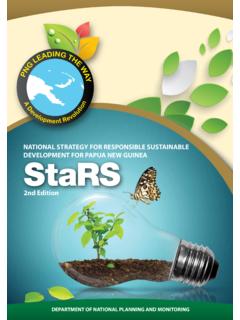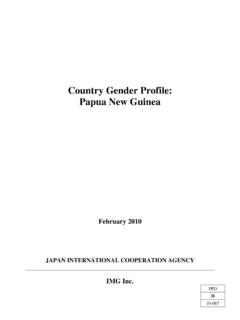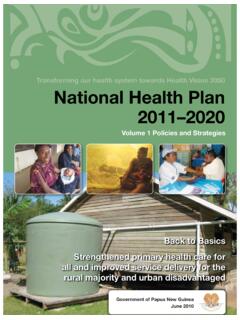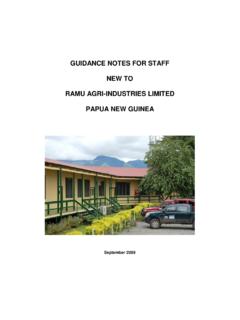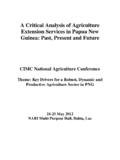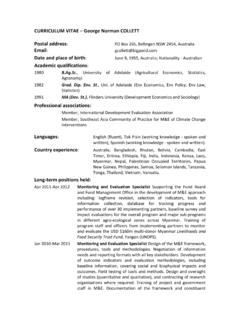Transcription of PAPUA NEW GUINEA DEVELOPMENT STRATEGIC …
1 PAPUA NEW GUINEA DEVELOPMENT STRATEGIC plan 2010 -2030 AN ASSESSMENT OF ITS CONSISTENCIES AND CORE ASSUMPTIONS BY PATRICK KAIKU PAPUA NEW GUINEA DEVELOPMENT STRATEGIC plan 2010 -2030 AN ASSESSMENT OF ITS CONSISTENCIES AND CORE ASSUMPTIONS 1 Cover imagery: 1. Hand woven garments (bilum wear) and bags (bilums) for sale in Goroko. Many women earn a substantial income from such craft industries but lack decent markets to sell their products. 2. Locally owned coconut plantation in New Ireland Province. The coconut industry has been sadly neglected by a government focused on large-scale foreign owned resource extraction. 3. Coffee is another vibrant locally owned industry. Coffee producers can sell bags of beans at the roadside to local entrepreneurs who then sell to exporters in the towns.
2 PAPUA NEW GUINEA DEVELOPMENT STRATEGIC plan 2010 -2030 AN ASSESSMENT OF ITS CONSISTENCIES AND CORE ASSUMPTIONS 2 PAPUA NEW GUINEA DEVELOPMENT STRATEGIC plan 2010 -2030 AN ASSESSMENT OF ITS CONSISTENCIES AND CORE ASSUMPTIONS Report commissioned by ACT NOW! This report is a follow-up to A Critical Analysis of PAPUA New GUINEA Vision 2050 (2015) which is available here: Box 5218, Boroko 111, National Capital District, PAPUA New GUINEA June 2016 Note about author: Patrick Kaiku teaches in the Political Science Strand at the University of PAPUA New GUINEA (UPNG). He attained a MA degree from the University of Hawai i at Manoa in 2011 where he majored in the Pacific Islands Studies Program. His previous consultancy work was in 2012 on political party institutionalization in PNG with the Washington National Democratic Institute (NDI).
3 PAPUA NEW GUINEA DEVELOPMENT STRATEGIC plan 2010 -2030 AN ASSESSMENT OF ITS CONSISTENCIES AND CORE ASSUMPTIONS 1 PAPUA NEW GUINEA DEVELOPMENT STRATEGIC plan 2010 -2030 AN ASSESSMENT OF ITS CONSISTENCIES AND CORE ASSUMPTIONS 1 CONTENTS Pages LIST OF 2 List of 3 EXECUTIVE 5-6 Key 6-8 1. The PNG DEVELOPMENT STRATEGIC plan 2010 9 What is the rationale for the PNGDSP s creation?.. 9-22 What are some of the salient features of the PNGDSP?.. 22-27 Structure of the 27-37 2. Consistency with Vision 2050 and the National Goals and Directive Principles 37 Consistency with Vision 37 The growth-oriented model of 38-40 Timeframes and quantifying 40-45 Equalization of DEVELOPMENT through broad-based 45-48 The Vision 2050 and the PNGDSP seek to address the cross-cutting developmental challenges in 48-50 Translating Vision 2050 into planning 50-52 Consistency with the 52 How the PNGSDP is consistent with the 52 Equal 53-55 Sustainable 55-57 How the PNGSDP is inconsistent with the.
4 57 The principles of equality and 57-59 Disempowering aspects of the 59-62 Compromising national economic sovereignty and 62-66 3. National Strategy for Responsible Sustainable DEVELOPMENT , Vision 2050 and the sustainability commitments of the NGDP .. 67 Commitment to mass-based participation and equal 67-70 Encouraging sustainable non-extractive sectors and sustainable DEVELOPMENT . 70-73 Economic 73-74 Integrating PAPUA New GUINEA Ways into natural resource DEVELOPMENT .. 74-76 77 Works 78-81 PAPUA NEW GUINEA DEVELOPMENT STRATEGIC plan 2010 -2030 AN ASSESSMENT OF ITS CONSISTENCIES AND CORE ASSUMPTIONS 2 LIST OF ACRONYMS ADB Asian DEVELOPMENT Bank BPNG Bank of PAPUA New GUINEA DNPM Department of National Planning and Monitoring ECIA Economic Corridor Implementation Authority GDP Gross Domestic Product GoPNG Government of PAPUA New GUINEA HDI Human DEVELOPMENT Index INA Institute of National Affairs LNG Liquefied Natural Gas MDGs Millennium DEVELOPMENT Goals NGDPs National Goals and Directive Principles NSPT National STRATEGIC plan Taskforce PNG PAPUA New GUINEA PNGDSP PAPUA New GUINEA DEVELOPMENT STRATEGIC plan 2010 -2030 PNGGEM - PNG Government s
5 Computerised General Equilibrium Model PRAEC Petroleum Resource Area Economic Corridor StARS National Strategy for Responsible Sustainable DEVELOPMENT SWF Sovereign Wealth Fund PAPUA NEW GUINEA DEVELOPMENT STRATEGIC plan 2010 -2030 AN ASSESSMENT OF ITS CONSISTENCIES AND CORE ASSUMPTIONS 3 List of Figures Figure 1: PNGDSP Conceptual 16 Figure 2: Proposed 10 economic corridors in the 19 Figure 3: An article on the plight of rural areas in PNG and the likely civil crisis this can 24 Figure 4: Agriculture and livestock key STRATEGIC 35 Figure 5: Budget outcomes for the periods 1990 to 48 Figure 6: The PNGSDP and its alignment to the NGDPs in the 55 Figure 7: Linking to the PNGDSP to the annual 63 Figure 8: The funding mechanism of the 66 Figure 9: STRATEGIC Planning Framework of 74 Figure 10: Measurement framework of the National Strategy for Responsible Sustainable 77 PAPUA NEW GUINEA DEVELOPMENT STRATEGIC plan 2010 -2030 AN ASSESSMENT OF ITS CONSISTENCIES AND CORE ASSUMPTIONS 4 PAPUA NEW GUINEA DEVELOPMENT STRATEGIC plan 2010 -2030 AN ASSESSMENT OF ITS CONSISTENCIES AND CORE ASSUMPTIONS 5 EXECUTIVE SUMMARY The PAPUA New GUINEA DEVELOPMENT STRATEGIC plan 2010 -2030 (hereafter PNGDSP) is a follow up DEVELOPMENT blueprint from the Vision 2050.
6 Under the PNGDSP, PAPUA New GUINEA (PNG) aspires to realize the ambitious aim of becoming a prosperous middle income country by 2030 . Unlike the Vision 2050 which aims to bring PNG within the middle income country status by 2050, the PNGDSP seeks to achieve this goal within a 20-year period. This study was commissioned by Act Now! The project s Terms of Reference established the parameters of the present analysis. The primary objectives were to: 1. Provide a brief of the PNG DEVELOPMENT STRATEGIC plan 2010 2030; 2. Determine the consistencies (or inconsistencies) with the Vision 2050 and the National Goals and Directive Principles (NGDP); and, 3. Determine if the National Strategy for Responsible Sustainable DEVELOPMENT (StaRS) is consistent with the sustainability commitments of the NGDP and Vision 2050.
7 The analysis involved a desktop review of the PNGDSP. Reading of the PNGDSP was complemented with additional research from DEVELOPMENT literature pertaining to the political economy of post-Independence PNG. Material was also sourced from the internet. The availability of updated and current materials on the internet provided useful information for comparative purposes. The PNGDSP takes a significantly interventionist tone where government undertakes serious public investment in creating the environment for economic growth and economic participation by PAPUA New Guineans. Not only is the Department of National Planning and Monitoring (DNPM) at the driver s seat of its implementation but there is also a concerted effort to address the apparent disparities in the distribution of economic benefits and the lack of equal opportunities available to PAPUA New Guineans.
8 In the main the PNGDSP uses the case of unequal distribution as the basis for intervention through the economic corridor concept. Within the structure of the economic corridor concept is specific reference to infrastructure DEVELOPMENT and specifically participation of PAPUA New Guineans in entrepreneurial and income-earning initiatives. The premise of the PNGDSP therefore is that rural poverty can be defined as the institutionalize disenfranchisement of the rural majority who remain less integrated into the mainstream economy . The study establishes that though the intentions of the PNGDSP are noble, the growth-oriented approach to DEVELOPMENT planning is at odds with the intentions of the National Goals and Directive Principles.
9 Indeed, in the third part of this study (where the National Strategy for Responsible Sustainable DEVELOPMENT s commitments to sustainable DEVELOPMENT are analyzed), it becomes obvious that the relentless push for economic growth under the PNGDSP and the Vision 2050 is undertaken without acknowledging the associated problems of the environmental and social costs to PNG society. Where much of the attention in the PNGDSP and Vision 2050 is on achieving economic growth, there is an emerging consensus that such models of DEVELOPMENT come at the expense of ecological sustainability and collective well-being. Likewise, using the PAPUA NEW GUINEA DEVELOPMENT STRATEGIC plan 2010 -2030 AN ASSESSMENT OF ITS CONSISTENCIES AND CORE ASSUMPTIONS 6 yardstick of the Human DEVELOPMENT Index (HDI) and Gross Domestic Product (GDP) are not wholly realistic measures of human well-being.
10 The timeliness of the National Strategy for Responsible Sustainable DEVELOPMENT is noted here because it has regenerated attention on our appreciation of the NGDPs in the context of DEVELOPMENT discourse in PNG. Key findings: The PNGDSP is a technocratic tool that seeks to guide how government addresses the maladies of PNG s distorted economic DEVELOPMENT with the emphasis on mass-based economic growth and targeted investments in impoverished regions of the country intended to spawn economic integration of these poverty corridors into the mainstream economy. Using the concept of economic corridors and specifically the Petroleum Resource Area Economic Corridor (PRAEC), it is envisaged that petroleum-producing provinces of Southern Highlands, parts of Enga, Gulf, and Central provinces will benefit from additional long term sustainable spin-off economic activities.
